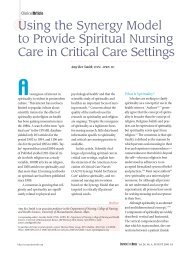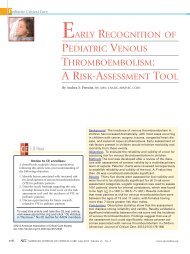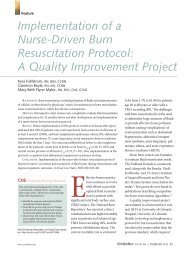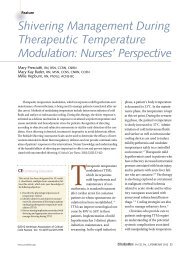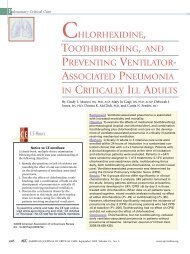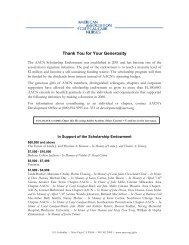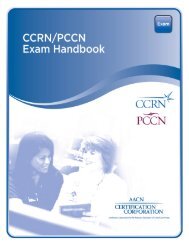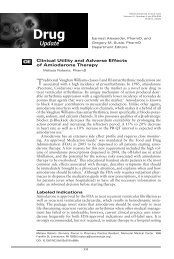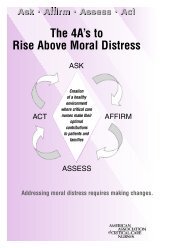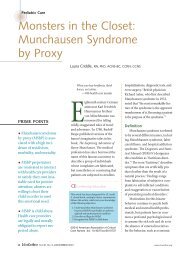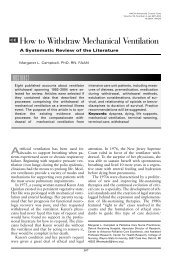Prevention of Aspiration Practice Alert - American Association of ...
Prevention of Aspiration Practice Alert - American Association of ...
Prevention of Aspiration Practice Alert - American Association of ...
Create successful ePaper yourself
Turn your PDF publications into a flip-book with our unique Google optimized e-Paper software.
<strong>Prevention</strong> <strong>of</strong> <strong>Aspiration</strong><br />
Scope and Impact <strong>of</strong> Problem<br />
Critically ill patients have an increased risk for aspirating oropharyngeal secretions and regurgitated gastric<br />
contents. For those who are tube-fed, aspiration <strong>of</strong> gastric contents is <strong>of</strong> greater concern. While witnessed<br />
large-volume aspirations occur occasionally, small-volume clinically silent aspirations are far more common. For<br />
example, a laboratory study identified frequent microaspirations in approximately half <strong>of</strong> a large population <strong>of</strong><br />
critically ill, mechanically ventilated patients who were receiving tube feedings. 1 In the same study, risk for<br />
pneumonia was about 4 times greater in patients identified as frequent aspirators. Because no bedside tests are<br />
currently available to detect microaspirations, efforts to prevent or minimize aspiration take on added<br />
importance.<br />
Expected <strong>Practice</strong><br />
Maintain head-<strong>of</strong>-bed elevation at an angle <strong>of</strong> 30 to 45 degrees, unless contraindicated. [Level B]<br />
Use sedatives as sparingly as feasible. [Level C]<br />
For tube-fed patients, assess placement <strong>of</strong> the feeding tube at 4-hour intervals. [Level C]<br />
For patients receiving gastric tube feedings, assess for gastrointestinal intolerance to the feedings at 4hour<br />
intervals. [Level C]<br />
For tube-fed patients, avoid bolus feedings in those at high risk for aspiration. [Level E]<br />
Consult with physician about obtaining a swallowing assessment before oral feedings are started for<br />
recently extubated patients who have experienced prolonged intubation. [Level C]<br />
Maintain endotracheal cuff pressures at an appropriate level, and ensure that secretions are cleared<br />
from above the cuff before it is deflated. [Level B]<br />
Supporting Evidence<br />
Head-<strong>of</strong>-Bed Elevation<br />
There is evidence that a sustained supine position (zero-degree head-<strong>of</strong>-bed elevation) increases<br />
gastroesophageal reflux and the probability for aspiration; for example, using a radioactive-labeled formula,<br />
endobronchial counts were higher when patients were lying flat in bed (zero degree) compared to when they<br />
were in a semirecumbent (45-degree) position. 2 Thus, elevating the head <strong>of</strong> the bed to an angle <strong>of</strong> 30 to 45<br />
degrees, unless contraindicated, is recommended for patients at high risk for aspiration pneumonia (eg, a<br />
patient receiving mechanical ventilation and/or one who has a feeding tube in place). 3,4 Although effectiveness<br />
<strong>of</strong> the reverse Trendelenberg position in minimizing aspiration has not been studied, it is likely to produce<br />
similar results to an elevated backrest position. 4<br />
1 <strong>of</strong> 6 Issued November 2011<br />
Linda Bell<br />
1
Sedation<br />
Sedation causes reduced cough and gag reflexes and can interfere with the patient’s ability to handle<br />
oropharyngeal secretions and refluxed gastric contents; in addition, sedation may slow gastric emptying. 5,6 To<br />
reduce the risk for aspiration, it is prudent to use the smallest effective level <strong>of</strong> sedation.<br />
Assess Feeding-Tube Placement at Regular Intervals<br />
Expert panels recommend that correct feeding-tube placement be verified at regular intervals to minimize the<br />
risk for aspiration. 3,4,7 If feedings are administered at the wrong site (such as the esophagus, or even the<br />
stomach <strong>of</strong> a patient who requires small-bowel feedings), the risk for aspiration is increased. 8 It is not<br />
uncommon for feeding tubes to become malpositioned during routine use. For example, in a study <strong>of</strong> 201<br />
critically ill patients, it was found that the distal tips <strong>of</strong> 24 <strong>of</strong> 116 feeding tubes originally positioned in the small<br />
bowel were displaced upward into the gastrointestinal tract (23 into the stomach and 1 into the esophagus). 9<br />
Assess for Gastrointestinal Intolerance to Tube Feedings<br />
Tube-fed patients who experience frequent regurgitation and aspiration <strong>of</strong> gastric contents are at increased risk<br />
for poor respiratory outcomes. 1 Guidelines developed jointly by the Society <strong>of</strong> Critical Care Medicine and the<br />
<strong>American</strong> Society for Parenteral and Enteral Nutrition recommend that patients be monitored for tolerance to<br />
enteral feedings by noting abdominal distention, complaints <strong>of</strong> abdominal pain, observing for passage <strong>of</strong> flatus<br />
and stool, and monitoring gastric residual volumes. 10 Because gastric distention predisposes to regurgitation, it<br />
is recommended that gastric residual volumes (GRVs) be measured every 4 hours in critically ill patients. 4<br />
<strong>Practice</strong> varies widely in regard to GRVs; however, 200 ml and 250 ml are frequently cited values for initial<br />
concern. 11,12 In a study <strong>of</strong> 206 critically ill patients, 2 or more GRVs <strong>of</strong> at least 200 ml and 1 or more GRVs <strong>of</strong> at<br />
least 250 ml were found significantly more <strong>of</strong>ten in patients who experienced frequent aspiration. 11 Prokinetics<br />
are sometimes advocated to improve gastric emptying when GRVs exceed a stipulated value. Several sources<br />
recommend that feedings be stopped when GRVs exceed 500 ml. 4,7<br />
In a study <strong>of</strong> gastrointestinal (GI) symptoms in critically ill patients, investigators found that those with 2 or more<br />
simultaneous GI symptoms (such as high gastric aspirate volume, absent or abnormal bowel sounds,<br />
vomiting/regurgitation, diarrhea, bowel distension, and gastrointestinal bleeding) were less likely to have<br />
successful enteral feedings than those with fewer than 2 GI symptoms (84% vs 12.2%, respectively, p < .001). 13<br />
Although bedside assessments for GI function such as GRVs and abdominal girth are difficult to evaluate, 14-16<br />
they are frequently used in combination to provide an estimate <strong>of</strong> GI tolerance to enteral feedings. Small bowel<br />
feeding with the tube’s ports situated at or below the Ligament <strong>of</strong> Treitz is strongly recommended for patients<br />
with persistent intolerance to gastric feedings and documented aspiration. 7<br />
Avoid Bolus Tube Feedings in Patients at High Risk for <strong>Aspiration</strong><br />
An expert panel has concluded that no recommendation can be made regarding the best type <strong>of</strong> formula<br />
delivery method (continuous or intermittent). 3 Also, no guidelines exist for bolus feedings. On the basis <strong>of</strong> logic,<br />
2 <strong>of</strong> 6 Issued November 2011<br />
Linda Bell<br />
2
however, administering an entire 4-hour volume <strong>of</strong> formula over a period <strong>of</strong> a few minutes is more likely to<br />
predispose to regurgitation <strong>of</strong> gastric contents than is the steady administration <strong>of</strong> the same volume over a<br />
period <strong>of</strong> 4 hours.<br />
Continuous feedings are used in most critical care units. Supportive <strong>of</strong> this action is a small study <strong>of</strong><br />
neurologically impaired adult patients; aspiration was observed more frequently in those with intermittent<br />
feedings (3 <strong>of</strong> 17) than in those who received continuous feedings (1 <strong>of</strong> 17). 17 It is possible that the bolus<br />
method <strong>of</strong> feeding may decrease the lower esophageal pressure and thus predispose patients to reflux and<br />
aspiration. 18 Other researchers reported that adult burn patients who received continuous tube feedings had<br />
less stool frequency and less time required to reach nutritional goals than did intermittently fed patients. 19<br />
Swallowing Assessment Before Oral Feedings for Recently Extubated Patients<br />
Tracheal intubation interferes with overall swallowing physiology. 20 Thus, it is reasonable to expect some degree<br />
<strong>of</strong> swallowing impairment when patients are initially extubated. A systematic literature review found that<br />
recently extubated patients were at increased risk for swallowing difficulties; more than 20% <strong>of</strong> the patients in<br />
many <strong>of</strong> the reviewed studies experienced dysphagia. 21<br />
Management <strong>of</strong> Endotracheal Tubes<br />
A persistent low cuff pressure (< 20 cm H2O) predisposes patients to pneumonia, presumably by predisposing to<br />
aspiration <strong>of</strong> oropharyngeal secretions and/or refluxed gastric contents. 22 To minimize aspiration <strong>of</strong> secretions<br />
pooled above the endotracheal tube’s cuff, hypopharyngeal suctioning should be performed before deflating<br />
the cuff. 3<br />
Actions for Nursing <strong>Practice</strong><br />
Maintain head-<strong>of</strong>-bed elevation at an angle <strong>of</strong> 30 to 45 degrees, unless contraindicated<br />
If backrest elevation is not tolerated, consider use <strong>of</strong> the reverse Trendelenberg position to elevate the<br />
head <strong>of</strong> the bed, unless contraindicated.<br />
If necessary to lower the head <strong>of</strong> bed for a procedure or a medical contraindication, return the patient<br />
to a head-<strong>of</strong>-bed elevated position as soon as feasible.<br />
Use sedatives as sparingly as feasible<br />
Use an appropriate sedation scale to guide the administration <strong>of</strong> sedatives.<br />
Consider clinical situations that affect the need for sedatives.<br />
For tube-fed patients, assess feeding-tube placement at 4-hour intervals to ensure the tube has remained in the<br />
desired location.<br />
Observe for a change in length <strong>of</strong> the external portion <strong>of</strong> the feeding tube, as determined by movement<br />
<strong>of</strong> the marked portion <strong>of</strong> the tube.<br />
Review routine chest and abdominal x-ray reports to look for notations about tube location.<br />
3 <strong>of</strong> 6 Issued November 2011<br />
Linda Bell<br />
3
Observe changes in volume <strong>of</strong> aspirate from the feeding tube; a large increase in volume may signal the<br />
upward dislocation <strong>of</strong> a small-bowel feeding tube into the stomach.<br />
If pH strips are available, measure the pH <strong>of</strong> feeding-tube aspirates if feedings are interrupted for more<br />
than a few hours. Also, observe the appearance <strong>of</strong> feeding-tube aspirates if feedings are interrupted for<br />
more than a few hours.<br />
Obtain an x-ray to confirm tube position if there is doubt about the tube’s position.<br />
For patients receiving gastric tube feedings, assess for intolerance to feedings every 4 hours by monitoring GRVs,<br />
abdominal discomfort, nausea/vomiting, and abdominal girth/tension<br />
Although it is easier to withdraw gastric contents from large-bore feeding tubes than from small-bore<br />
tubes, it is important to measure residual volumes from all types <strong>of</strong> gastric tubes, including gastrostomy<br />
tubes.<br />
o A 60 ml syringe is most suitable for measuring residual volumes.<br />
o It is helpful to inject 30 ml <strong>of</strong> air before attempting to aspirate fluid from flexible, small-diameter<br />
tubes.<br />
o Withdraw as much fluid as possible to make an accurate assessment.<br />
o It may be helpful to reposition the patient to facilitate withdrawal <strong>of</strong> fluid from the tube (for<br />
example, turning the patient from side to side may allow the feeding tube’s ports to enter a pool<br />
<strong>of</strong> gastric fluid).<br />
If patients are able to communicate, ask if they are experiencing abdominal discomfort or nausea. If<br />
vomiting is present, feedings should be stopped, and the physician notified.<br />
Palpate the abdomen for firmness; a millimeter tape may be used to measure abdominal girth.<br />
Evaluate the significance <strong>of</strong> a single abnormal finding, such as a high GRV, in relation to other indicators<br />
<strong>of</strong> GI intolerance to tube feedings, such as abdominal distention, abdominal discomfort, and nausea and<br />
vomiting.<br />
Although clinicians disagree about the necessity for small bowel feedings to minimize aspiration risk in<br />
all critically ill patients, small bowel feedings have been recommended when patients are intolerant <strong>of</strong><br />
gastric feedings or when they have documented aspiration. 7<br />
For tube-fed patients, avoid bolus feedings for those at high risk for aspiration<br />
As indicated above, it is better to introduce feedings evenly over a period <strong>of</strong> hours to minimize risk for<br />
regurgitation and aspiration <strong>of</strong> gastric contents.<br />
Consult with a dietitian and a physician about the best feeding method for individual patients.<br />
Consult with the patient’s physician about obtaining a swallowing assessment before beginning oral feedings for<br />
a recently extubated patient who has undergone prolonged intubation<br />
As indicated above, studies have shown that patients may experience dysphagia following extubation,<br />
especially if intubation has been prolonged. As such, it is prudent to observe for swallowing problems<br />
before introducing oral feedings. If a swallowing assessment is needed, it will likely be performed by a<br />
speech pathologist.<br />
4 <strong>of</strong> 6 Issued November 2011<br />
Linda Bell<br />
4
Maintain endotracheal cuff pressures at an appropriate level<br />
The <strong>American</strong> Thoracic Society recommends that endotracheal tube cuff pressure be maintained at > 20<br />
cm H2O to prevent leakage <strong>of</strong> secretions around the cuff into the lower respiratory tract. 23<br />
Moreover, it has been recommended that cuff pressure be maintained at < 30 cm H2O to prevent<br />
tracheal injury. 24<br />
To minimize aspiration <strong>of</strong> pooled secretions from above the cuff, hypopharyngeal suctioning is<br />
recommended before the cuff is deflated. 3<br />
AACN Levels <strong>of</strong> Evidence<br />
Level A Meta-analysis <strong>of</strong> quantitative studies or metasynthesis <strong>of</strong> qualitative studies with results that consistently support a<br />
specific action, intervention, or treatment<br />
Level B Well-designed, controlled studies with results that consistently support a specific action, intervention, or treatment<br />
Level C Qualitative studies, descriptive or correlational studies, integrative reviews, systematic reviews, or randomized<br />
controlled trials with inconsistent results<br />
Level D Peer-reviewed pr<strong>of</strong>essional and organizational standards with the support <strong>of</strong> clinical study recommendations<br />
Level E Multiple case reports, theory-based evidence from expert opinions, or peer-reviewed pr<strong>of</strong>essional organizational<br />
standards without clinical studies to support recommendations<br />
Level M Manufacturer’s recommendations only<br />
Need More Information or Help?<br />
Contact a clinical practice specialist for additional information (www.aacn.org); then select <strong>Practice</strong> Resource<br />
Network and Ask the Clinical <strong>Practice</strong> Team.<br />
References<br />
1. Metheny NA, Clouse RE, Chang YH, Stewart BJ, Oliver DA, Kollef MH. Tracheobronchial aspiration <strong>of</strong> gastric<br />
contents in critically ill tube-fed patients: frequency, outcomes, and risk factors. Crit Care Med.<br />
2006;34(4):1007-1015.<br />
2. Torres A, Serra-Bailles J, Ros E, Piera C, et al. Pulmonary aspiration <strong>of</strong> gastric contents in patients receiving<br />
mechanical ventilation: the effect <strong>of</strong> body position. Ann Intern Med. 1992; 116(7):540-543.<br />
3. Tablan OC, Anderson LJ, Besser R, Bridges C, Hajjeh R. Guidelines for preventing health-care associated<br />
pneumonia, 2003: recommendations <strong>of</strong> CDC and the Healthcare Infection Control <strong>Practice</strong>s Advisory<br />
Committee. MMWR Recomm Rep. 2004;53(RR-3):1-36.<br />
4. Bankhead R, Boullata J, Brantley S, et al. Enteral nutrition practice recommendations. JPEN J Parenter Enteral<br />
Nutr. 2009;33(2):122-167.<br />
5. Nishino T. Physiological and pathophysiological implications <strong>of</strong> upper airway reflexes in humans. Jpn J<br />
Physiol. 2000;50(1):3-14.<br />
6. Kao CH, ChangLai SP, Chieng PU, Yen TC. Gastric emptying in head-injured patients. Am J Gastroenterol.<br />
1998;93(7):1108-1112.<br />
7. McClave SA, DeMeo MT, DeLegge MH, et al. North <strong>American</strong> summit on aspiration in the critically ill patient:<br />
consensus statement. JPEN J Parenter Enteral Nutr. 2002;26(6 Suppl):S80-S85.<br />
8. Metheny NA, Clouse RE, Clark JM, Reed L, Wehrle MA, Wiersema L. pH testing <strong>of</strong> feeding-tube aspirates to<br />
determine placement. Nutr Clin Pract. 1994;9(5):185-190.<br />
5 <strong>of</strong> 6 Issued November 2011<br />
Linda Bell<br />
5
9. Metheny NA, Schnelker R, McGinnis J, et al. Indicators <strong>of</strong> tubesite during feedings. J Neurosci Nurs.<br />
2005;37(6):320-325.<br />
10. McClave SA, Martindale RG, Vanek VW, et al. Guidelines for the provision and assessment <strong>of</strong> nutrition<br />
support therapy in the adult critically ill patient: Society <strong>of</strong> Critical Care Medicine (SCCM) and <strong>American</strong><br />
Society for Parenteral and Enteral Nutrition (A.S.P.E.N.). JPEN J Parenter Enteral Nutr. 2009;33(3):277-316.<br />
11. Metheny NA, Schallom L, Oliver DA, Clouse RE. Gastric residual volume and aspiration in critically ill patients<br />
receiving gastric feedings. Am J Crit Care. 2008;17(5):512-519.<br />
12. Pinilla JC, Samphire J, Arnold C, Liu L, Thiessen B. Comparison <strong>of</strong> gastrointestinal tolerance to two feeding<br />
protocols in critically ill patients: a prospective, randomized controlled trial. JPEN J Parenter Enteral Nutr.<br />
2001;25(2):81-86.<br />
13. Reintam A, Parm P, Kitus R, Kern H, Starkopf J. Gastrointestinal symptoms in intensive care patients. Acta<br />
Anaesthesiol Scand. 2009;53(3):318-324.<br />
14. O’Meara D, Mireles-Cabodevila E, Frame F, et al. Evaluation <strong>of</strong> delivery <strong>of</strong> enteral nutrition in critically ill<br />
patients receiving mechanical ventilation. Am J Crit Care. 2008;17(1):53-61.<br />
15. Chan LN. A ‘gutsy move’: Tackling enteral feeding intolerance in critically ill patients. Nutr Clin Pract.<br />
2010;25(1):10-12.<br />
16. Btaiche IF, Chan LN, Pleva M, Kraft MD. Critical illness, gastrointestinal complications, and medication<br />
therapy during enteral feeding in critically ill adult patients. Nutr Clin Pract. 2010;25(1):32-49.<br />
17. Kocan MJ, Hickisch SM. A comparison <strong>of</strong> continuous and intermittent enteral nutrition in NICU patients. J<br />
Neurosci Nurs. 1986;18(6):333-337.<br />
18. Coben RM, Weintraub A, DiMarino AJ Jr, Cohen S. Gastroesophageal reflux during gastrostomy feeding.<br />
Gastroenterology. 1994;106:13-18.<br />
19. Hiebert JM, Brown A, Anderson RG, Halfacre S, Rodeheaver GT, Edlich RF. Comparison <strong>of</strong> continuous vs<br />
intermittent tube feedings in adult burn patients. JPEN J Parenter Enteral Nutr. 1981;5(1):73-75.<br />
20. Tolep K, Getch CL, Criner GJ. Swallowing dysfunction in patients receiving prolonged mechanical ventilation.<br />
Chest. 1996;109(1):167-172.<br />
21. Skoretz SA, Flowers HL, Martino R. The incidence <strong>of</strong> dysphagia following endotracheal intubation: a<br />
systematic review. Chest. 2010;137(3):665-673.<br />
22. Rello J, Sonora R, Jubert P, Artigas A, Rue M, Valles J. Pneumonia in intubated patients: role <strong>of</strong> respiratory<br />
airway care. Am J Respir Crit Care Med. 1996;154(1):111-115.<br />
23. <strong>American</strong> Thoracic Society, Infectious Diseases Society <strong>of</strong> America. Guidelines for the management <strong>of</strong> adults<br />
with hospital-acquired, ventilator-associated, and healthcare-associated pneumonia. Am J Respir Crit Care<br />
Med. 2005;171(4):388-416.<br />
24. Lorente L, Blot S, Rello J. New issues and controversies in the prevention <strong>of</strong> ventilator-associated<br />
pneumonia. Am J Respir Crit Care Med. 2010;182(7):870-876.<br />
6 <strong>of</strong> 6 Issued November 2011<br />
Linda Bell<br />
6



